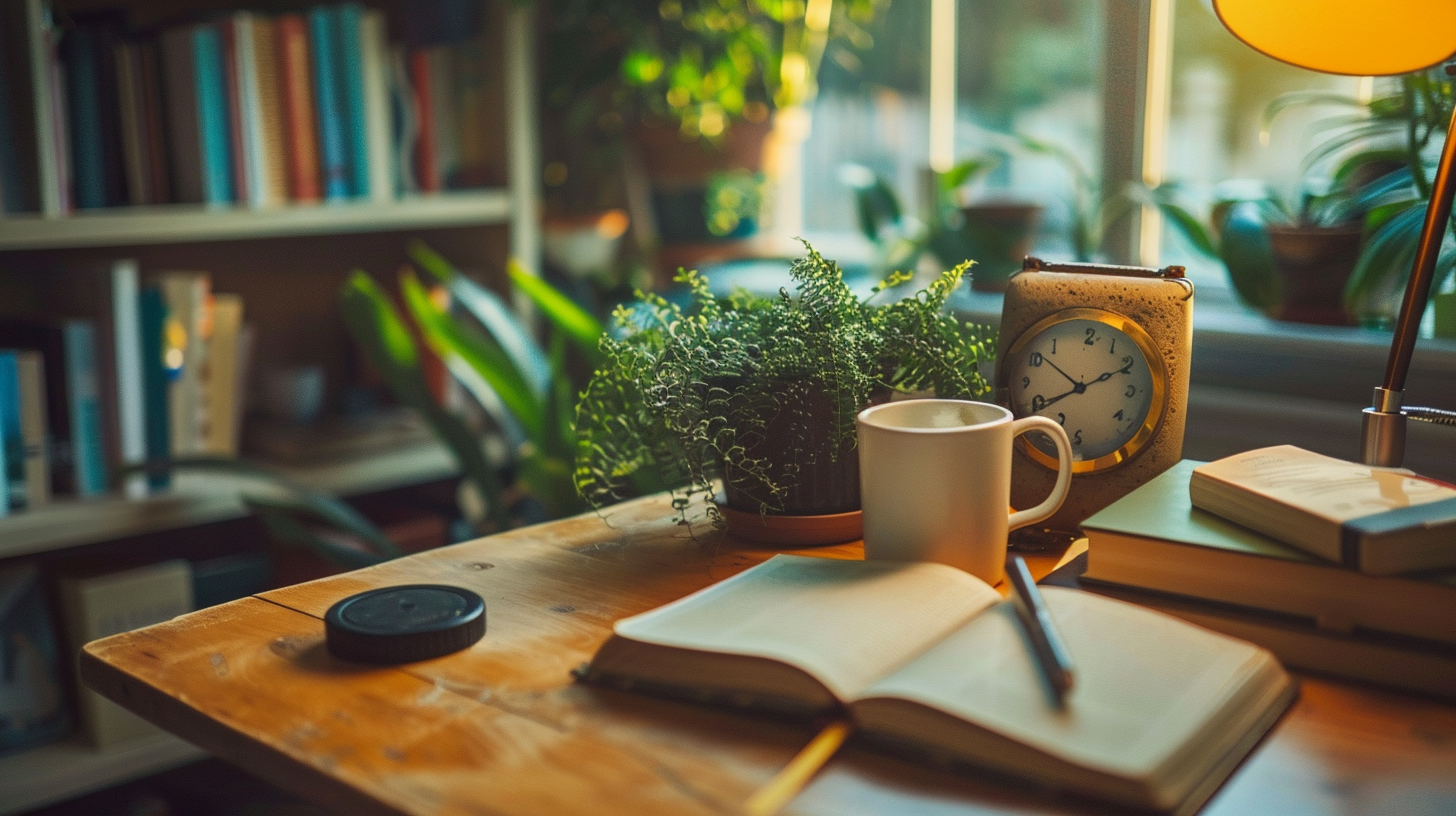Table of Contents Show
There may be products. Products are independently selected by our editors. We may earn an affiliate commission from the links with no charge to you, example: as Amazon Affiliate.
Equating busyness with productivity may seem like a badge of honor, but in reality, it can hinder our creativity, causing overwhelm and a lack of focus. Slow living emphasizes mindfulness and intentionality, leading to a more balanced and fulfilling lifestyle. By embracing a slower pace, we can enhance mental clarity, reduce stress, and foster stronger connections. Discovering the value of slow living goes beyond busyness to cultivate gratitude, creativity, and a deeper sense of purpose. Adapting a slower approach can have numerous benefits for our well-being and productivity.
Key Takeaways
- Slow living promotes mindfulness and intentional living for a balanced lifestyle.
- Quality over quantity is emphasized in slow living philosophy.
- Slowing down enhances mental clarity, reduces stress, and fosters creativity.
- Deep connections and meaningful relationships are prioritized over busyness.
- Embracing slowness leads to increased productivity, better decision-making, and a deeper sense of fulfillment.
The Myth of Productivity Culture
Often, we mistakenly equate busyness with productivity, perpetuating the myth of productivity culture in our modern society. We tend to measure our worth by the number of tasks we accomplish rather than the quality of our work or the impact we create. This mindset leads to a constant state of rushing, multitasking, and feeling overwhelmed, which hinders our ability to think creatively and innovatively.
In a world that values speed and instant gratification, we often overlook the importance of taking a step back, reflecting, and allowing ideas to incubate. True innovation stems from moments of quiet contemplation and deep focus, not from a never-ending cycle of busyness. Embracing a slower pace of life allows us to recharge our creative energies, cultivate deep connections, and approach challenges with a fresh perspective.
Let’s shift our mindset from glorifying busyness to valuing intentionality and purpose in our actions. By breaking free from the productivity myth, we open ourselves up to a world of possibilities and true innovation.
Understanding Slow Living Philosophy
Exploring the essence of the Slow Living philosophy reveals a profound shift towards mindfulness and intentional living. Slow Living encourages individuals to savor each moment, prioritize what truly matters, and embrace a more balanced lifestyle. It’s about quality over quantity, depth over superficiality, and presence over distraction. By slowing down, we can cultivate a greater sense of fulfillment and connection with ourselves and the world around us.
To illustrate the core principles of Slow Living, let’s examine the following table:
| Core Principles of Slow Living | Description | Benefits |
|---|---|---|
| Mindfulness | Being fully present in the moment | Reduced stress levels |
| Intentional Living | Making conscious choices aligned with values | Enhanced overall well-being |
| Simplifying | Removing unnecessary clutter and distractions | Increased clarity and focus |
Embracing Slow Living means embracing a more deliberate and enriching way of life, where purpose and contentment take precedence over the constant pursuit of busyness.
Benefits of Embracing Slowness
Embracing the principles of Slow Living leads to a range of tangible benefits that positively impact our well-being and overall satisfaction with life. By intentionally slowing down and focusing on the present moment, we allow ourselves the opportunity to fully engage with our surroundings and experiences. This heightened awareness not only reduces stress and anxiety but also fosters creativity and innovation.
One of the key advantages of embracing slowness is the improvement in mental clarity and focus. When we take the time to slow down, we give our minds the chance to rest and recharge, leading to increased productivity and better decision-making. Additionally, by savoring each moment and paying attention to the details, we cultivate a deeper sense of gratitude and fulfillment in our daily lives.
Moreover, adopting a slower pace allows us to build stronger connections with others and strengthen our relationships. By being fully present in our interactions, we demonstrate respect and empathy, fostering deeper bonds and a sense of community. Overall, embracing slowness opens up a world of possibilities and enriches our lives in ways we never imagined.
Mindfulness in Everyday Activities
Incorporating mindfulness into daily tasks enhances my focus and presence in each moment, fostering a deeper connection with my surroundings. When I engage in activities with mindful awareness, I immerse myself fully in the present experience, savoring the richness of each moment. Whether it’s sipping a morning cup of tea or taking a walk in nature, mindfulness allows me to appreciate the intricate details that often go unnoticed in the rush of daily life.
By practicing mindfulness in everyday activities, I cultivate a sense of calm and clarity that sharpens my creativity and problem-solving skills. This heightened awareness enables me to approach challenges with a fresh perspective, leading to innovative solutions and breakthrough ideas. Moreover, mindfulness empowers me to respond to situations with intention rather than reacting impulsively, fostering better relationships and communication.
In essence, mindfulness isn’t just a practice but a transformative way of living that infuses each moment with purpose and meaning. Embracing mindfulness in daily activities opens doors to new possibilities and enriches my life with a sense of presence and fulfillment.
Prioritizing Quality Over Quantity
I focus on quality rather than quantity to ensure that each endeavor I undertake is meaningful and impactful. In a world obsessed with speed and output, I believe that true innovation and progress stem from the depth and excellence of our work rather than the sheer volume of tasks we accomplish. By prioritizing quality, I dedicate the necessary time and attention to refine my ideas, products, and interactions, ensuring they meet the highest standards.
Quality over quantity fosters a culture of excellence where each project is a masterpiece rather than a mere checkbox on a to-do list. This approach allows for creativity to flourish, enabling me to explore new ideas and push boundaries. Emphasizing quality also cultivates a sense of pride and fulfillment in my work, knowing that I’ve poured my best efforts into everything I do.
In a world inundated with quick fixes and instant gratification, choosing quality over quantity is a revolutionary act of defiance. It signifies a commitment to excellence, innovation, and lasting impact, setting a new standard for success in our fast-paced society.
Cultivating Meaningful Connections
Choosing to prioritize quality over quantity naturally leads me to focus on cultivating meaningful connections in both my personal and professional life.
In a world that often values superficial interactions and endless networking, I find that investing time and energy into forming genuine relationships yields far greater rewards. By engaging in deep conversations, actively listening, and showing genuine interest in others, I’m able to forge connections that aren’t only enriching but also have the potential to spark creativity and collaboration.
In my professional life, I seek to build meaningful connections with colleagues, clients, and industry peers. These relationships aren’t just about expanding my network; they’re about creating bonds based on mutual respect and shared values. By fostering these connections, I not only enhance my professional opportunities but also create a supportive community that encourages growth and innovation.
Similarly, in my personal life, I prioritize cultivating deep connections with friends and family. These relationships provide me with a sense of belonging, support, and fulfillment that’s essential for my overall well-being. By valuing quality over quantity in my relationships, I’m able to nurture connections that bring joy, meaning, and purpose to my life.
Slowing Down for Mental Well-being
I find that incorporating mindfulness practices into my daily routine helps me achieve a sense of calmness amidst life’s chaos.
Self-care has become non-negotiable for me, as it’s vital for maintaining my mental well-being.
Establishing healthy boundaries has been instrumental in protecting my mental health and overall well-being.
Mindfulness Practices for Calmness
Embracing mindfulness practices allows one to cultivate calmness and enhance mental well-being by slowing down and focusing on the present moment. By incorporating techniques like deep breathing, body scans, and guided meditation into daily routines, individuals can train their minds to stay grounded and centered amidst the chaos of modern life.
Mindfulness not only reduces stress and anxiety but also improves cognitive function and emotional regulation. Through consistent practice, one can develop a heightened sense of self-awareness and a greater capacity for resilience in the face of challenges.
This intentional focus on the here and now fosters a sense of peace and clarity, empowering individuals to approach life with a renewed perspective and a sharper mind.
Importance of Self-Care
Slowing down and prioritizing self-care is essential for maintaining optimal mental well-being in today’s fast-paced world. As I navigate the demands of modern life, I’ve come to realize that taking time for myself isn’t just a luxury; it’s a necessity.
Engaging in self-care practices, whether it’s meditation, exercise, or simply unplugging from technology, allows me to recharge and refocus. This intentional pause enables me to approach challenges with a clearer mind and a calmer demeanor.
Healthy Boundaries for Well-Being
Prioritizing healthy boundaries is crucial for cultivating well-being and promoting mental health in our fast-paced world. Setting clear limits on work hours, personal time, and digital engagement is essential for reducing stress and preventing burnout.
By establishing boundaries, we create space for relaxation, creativity, and meaningful connections. Embracing a slower pace allows us to focus on self-reflection, personal growth, and overall life satisfaction. It enables us to be fully present in each moment, enhancing our productivity and fostering a sense of fulfillment.
Incorporating mindfulness practices, such as meditation and deep breathing exercises, can further support our mental well-being and emotional resilience. Remember, boundaries aren’t restrictions; they’re liberating tools that empower us to lead healthier, more balanced lives.
Practical Tips for Slow Living
I find that incorporating mindful daily routines, simplifying possessions, and embracing quiet moments are key elements in practicing slow living.
By being intentional with my actions throughout the day, decluttering my physical space, and taking time to appreciate the stillness around me, I can cultivate a more balanced and fulfilling lifestyle.
These practical tips help me prioritize what truly matters and create space for greater peace and contentment in my daily life.
Mindful Daily Routines
In the quiet morning hours, a gentle ritual of brewing a steaming cup of tea sets the tone for a mindful day ahead. As I sip the soothing brew, I engage in a brief meditation session, grounding myself in the present moment. This practice allows me to approach the day with clarity and intention, fostering a sense of calm amidst the chaos.
Throughout the day, I incorporate small mindful moments, like taking short breaks to breathe deeply or appreciating the beauty of nature during a walk. These simple yet powerful routines help me stay centered and focused, enhancing my productivity and overall well-being.
Embracing mindfulness in daily routines isn’t just a trend; it’s a transformative way of living that promotes innovation and creativity.
Simplifying Possessions
Amidst the hustle and bustle of modern life, decluttering possessions can be a liberating and transformative step towards embracing the essence of slow living. Here are some practical tips for simplifying possessions:
- Start Small: Begin with one area at a time to avoid feeling overwhelmed.
- Embrace Minimalism: Keep only the items that serve a purpose or bring you joy.
- Digitize Where Possible: Scan documents and photos to reduce physical clutter.
- Donate or Sell Unneeded Items: Let go of things that no longer add value to your life.
- Create Designated Spaces: Design areas in your home for specific items to maintain organization and clarity.
Embracing Quiet Moments
Simplifying possessions can create space for embracing quiet moments in the journey towards slow living. By decluttering our surroundings, we invite tranquility and mindfulness into our daily lives. Here are some practical tips to help you embrace quiet moments and cultivate a slower pace:
| Tips for Embracing Quiet Moments |
|---|
| 1. Mindful Breathing |
| 2. Daily Meditation |
| 3. Nature Walks |
These practices can help you disconnect from the constant rush of life and reconnect with yourself. Embracing quiet moments allows for introspection, creativity, and a deeper appreciation of the present. Take a moment today to pause, breathe, and savor the stillness around you.
Frequently Asked Questions
How Can Slow Living Help Improve Relationships and Connections With Others?
Slow living fosters deeper connections and enhances relationships by allowing time for meaningful conversations and shared experiences. It cultivates presence, empathy, and understanding, leading to more authentic and fulfilling interactions with others.
What Are Some Practical Ways to Incorporate Mindfulness Into Everyday Tasks?
Incorporating mindfulness into daily tasks transforms routines into moments of awareness and peace. By breathing deeply while washing dishes or focusing on sensations during a walk, mundane activities become opportunities for calm reflection.
Can Embracing Slowness Actually Increase Productivity in the Long Run?
Embracing slowness can increase productivity in the long run. By focusing on quality over speed, taking breaks, and being mindful of priorities, I’ve found that my work is more efficient and effective.
How Does Prioritizing Quality Over Quantity Impact Overall Well-Being and Satisfaction?
Prioritizing quality over quantity brings depth to experiences, improving overall well-being and satisfaction. This mindset fosters meaningful connections, fuels creativity, and enhances personal growth. Quality enriches life; it’s the essence of fulfillment.
Are There Specific Strategies for Slowing Down That Can Benefit Mental Health and Reduce Stress Levels?
Slowing down benefits mental health and reduces stress. I prioritize self-care, like meditation and setting boundaries. These strategies help me stay grounded and focused. It’s essential to find what works for you in managing the pace of life.
Conclusion
In conclusion, embracing slow living isn’t about being lazy or unproductive, but rather about prioritizing quality over quantity and finding meaning in everyday moments.
While the fast-paced culture may tempt us with the idea that busyness equals success, it’s essential to remember that true fulfillment comes from taking the time to slow down, be present, and savor the richness of life.
So, why rush through life when we can choose to truly live it?









